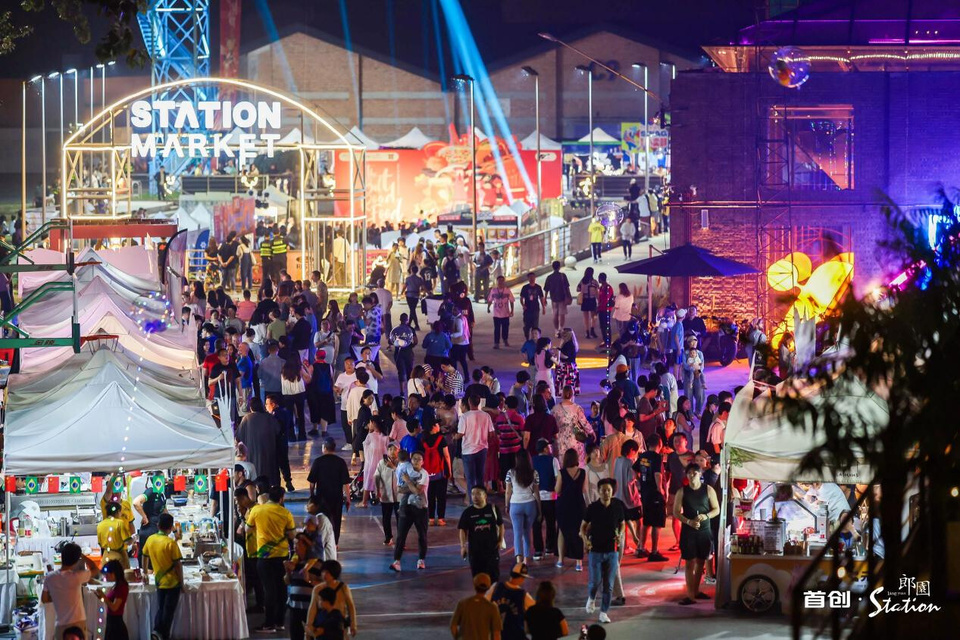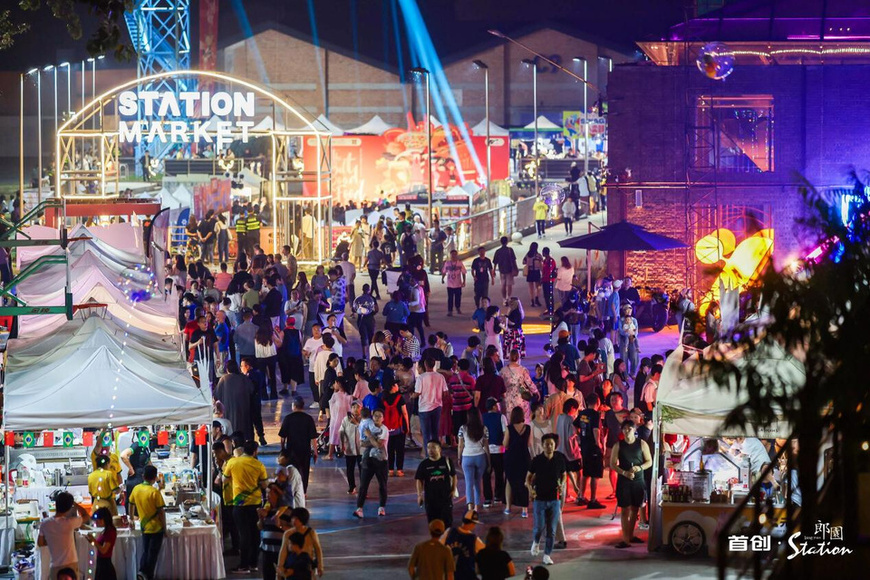By Li Jie
At Langyuan Station, a creative commercial compound nestled just outside Beijing's East fifth ring road, visitors wander past red-brick warehouses, rusted railway tracks, and lush greenery, browsing a curated selection of lifestyle brands. The open-air site - a blend of nostalgia and innovation - offers a refreshingly different kind of consumer experience.
Once a textile warehouse complex with over 40 years of history, Langyuan Station underwent a sweeping urban renewal project in 2019. Today, it thrives as a vibrant hub for cultural and commercial activity, featuring film and TV studios, boutique cafes, bookstores, art galleries, designer furniture showrooms, niche retail stores, and live music bars.
Such destinations reflect a growing appetite among Chinese consumers for what has come to be known as "non-standard commercial projects" - a term gaining popularity in China's evolving retail landscape.
These non-standard commercial projects stand in contrast to traditional shopping malls and department stores. Rather than conforming to conventional formats, they emphasize individuality, differentiation, and immersive experience. According to an industry report, such projects typically distinguish themselves through innovative spatial design, creative experiences, diversified business mixes, and alternative operational models.
In recent years, the number of these projects has expanded rapidly, particularly in China's first- and second-tier cities. Some focus on repurposing historical sites, such as Shanghai's Hongshoufang area, where restored heritage buildings now serve as lively intersections of community life and contemporary culture. Others, such as THE BOX Chaowai, target younger, lifestyle-oriented urban consumers.
Generally more compact - often under 50,000 square meters - and highly flexible in layout, many non-standard projects incorporate open-air designs with green spaces and leisure zones. These are not simply places to shop, but also to gather, explore, and engage.
Inside Ziinlife, a designer furniture store at Langyuan Station, a soaring nine-meter-tall space has been transformed into a two-floor structure. Customers ascend wooden stairs to discover a curated experience of modern home aesthetics.
"This type of spatial design would be nearly impossible in a traditional shopping mall," said store manager Li Fei. Years ago, when scouting for a new retail location, they chose Langyuan Station over a conventional mall because of lower operating costs and a more precisely targeted customer base.
"Unlike standardized malls, this park gives brands much more creative freedom," Li said. "The atmosphere here, co-created by the site and its tenants, attracts a higher concentration of target customers," said Li.
The boom in non-standard retail highlights two broader trends in China's consumer landscape. First, ongoing urban renewal campaigns are breathing new life into aging neighborhoods, industrial zones and obsolete commercial complexes. Second, as the growth of traditional malls slows - amid increasing sameness and saturation - non-standard spaces offer fertile ground for innovation and value creation.
These developments are resonating on social media, where non-standard retail destinations often trend for their dynamic mix of pop-up events, weekend markets, and interactive exhibitions. They have quickly become sites not only of commerce but also for cultural conservation.
Still, the model is not without its challenges. Remote locations, limited size, and the risk of fading appeal after an initial buzz all pose obstacles.
"At Langyuan Station, we follow three guiding principles: industrial logic, community logic, and design-driven logic," explained Zhao Chunyan, general manager of Langyuan Culture Development Co., Ltd.
Zhao explained that "industrial logic" ensures that each storefront is backed by a robust business or creative industry. "Community logic" emphasizes a brand's ability to build and manage its own loyal following through strong private traffic channels. "Design-driven logic" highlights the need for distinctive visual identity and spatial aesthetics - both to elevate the on-site experience and to amplify its cultural appeal and online visibility.
Take, ACTION, a cafe and restaurant entirely devoted to cinema. From its menu and posters to decor, everything reflects film culture. On weekends, the venue buzzes with visitors. Behind the scenes, the business is operated by a film post-production company, making the restaurant a creative extension of its brand into the realm of physical retail.
In Zhao's view, every non-standard commercial project must offer something unique. Unlike traditional malls, these concepts cannot be mass-replicated, as its strength lies in originality.
Once a textile warehouse complex with over 40 years of history, Langyuan Station underwent a sweeping urban renewal project in 2019. Today, it thrives as a vibrant hub for cultural and commercial activity, featuring film and TV studios, boutique cafes, bookstores, art galleries, designer furniture showrooms, niche retail stores, and live music bars.
Such destinations reflect a growing appetite among Chinese consumers for what has come to be known as "non-standard commercial projects" - a term gaining popularity in China's evolving retail landscape.
These non-standard commercial projects stand in contrast to traditional shopping malls and department stores. Rather than conforming to conventional formats, they emphasize individuality, differentiation, and immersive experience. According to an industry report, such projects typically distinguish themselves through innovative spatial design, creative experiences, diversified business mixes, and alternative operational models.
In recent years, the number of these projects has expanded rapidly, particularly in China's first- and second-tier cities. Some focus on repurposing historical sites, such as Shanghai's Hongshoufang area, where restored heritage buildings now serve as lively intersections of community life and contemporary culture. Others, such as THE BOX Chaowai, target younger, lifestyle-oriented urban consumers.
Generally more compact - often under 50,000 square meters - and highly flexible in layout, many non-standard projects incorporate open-air designs with green spaces and leisure zones. These are not simply places to shop, but also to gather, explore, and engage.
Inside Ziinlife, a designer furniture store at Langyuan Station, a soaring nine-meter-tall space has been transformed into a two-floor structure. Customers ascend wooden stairs to discover a curated experience of modern home aesthetics.
"This type of spatial design would be nearly impossible in a traditional shopping mall," said store manager Li Fei. Years ago, when scouting for a new retail location, they chose Langyuan Station over a conventional mall because of lower operating costs and a more precisely targeted customer base.
"Unlike standardized malls, this park gives brands much more creative freedom," Li said. "The atmosphere here, co-created by the site and its tenants, attracts a higher concentration of target customers," said Li.
The boom in non-standard retail highlights two broader trends in China's consumer landscape. First, ongoing urban renewal campaigns are breathing new life into aging neighborhoods, industrial zones and obsolete commercial complexes. Second, as the growth of traditional malls slows - amid increasing sameness and saturation - non-standard spaces offer fertile ground for innovation and value creation.
These developments are resonating on social media, where non-standard retail destinations often trend for their dynamic mix of pop-up events, weekend markets, and interactive exhibitions. They have quickly become sites not only of commerce but also for cultural conservation.
Still, the model is not without its challenges. Remote locations, limited size, and the risk of fading appeal after an initial buzz all pose obstacles.
"At Langyuan Station, we follow three guiding principles: industrial logic, community logic, and design-driven logic," explained Zhao Chunyan, general manager of Langyuan Culture Development Co., Ltd.
Zhao explained that "industrial logic" ensures that each storefront is backed by a robust business or creative industry. "Community logic" emphasizes a brand's ability to build and manage its own loyal following through strong private traffic channels. "Design-driven logic" highlights the need for distinctive visual identity and spatial aesthetics - both to elevate the on-site experience and to amplify its cultural appeal and online visibility.
Take, ACTION, a cafe and restaurant entirely devoted to cinema. From its menu and posters to decor, everything reflects film culture. On weekends, the venue buzzes with visitors. Behind the scenes, the business is operated by a film post-production company, making the restaurant a creative extension of its brand into the realm of physical retail.
In Zhao's view, every non-standard commercial project must offer something unique. Unlike traditional malls, these concepts cannot be mass-replicated, as its strength lies in originality.
 Menu
Menu
 Rise of 'non-standard retail' sparks new consumer vitality in China
Rise of 'non-standard retail' sparks new consumer vitality in China

















